Life in the Time of Sailing Ships by Jayne Davis #History #Ships #Regency @jaynedavis142
Life in the Time of Sailing Ships By Jayne Davis
Some nautical phrases that have entered everyday language, and changed their meaning.A second-rate ship…Today, this phrase would mean a ship that was sub-standard in some way, not as good as it could be. This was the case originally, too, but only in terms of fire-power. Warships were rated from 1st rate to 6th rate depending on the number of guns they were designed to carry. This also correlated with the size of the vessel – the more guns it carried, the more men were needed to man them and the bigger the ship had to be.Nelson’s flagship, HMS Victory, had 104 guns on three gun decks, making it a 1st rate ship of the line.
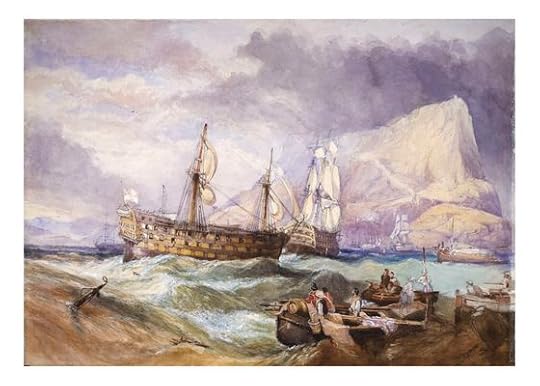 The damaged HMS Victory being towed into Gibraltar after the Battle of Trafalgar. HMS Victory is now in Portsmouth Historic Dockyard in the UK.
The damaged HMS Victory being towed into Gibraltar after the Battle of Trafalgar. HMS Victory is now in Portsmouth Historic Dockyard in the UK.The table shows the rating system used during the Napoleonic Wars. (Information from Wikipedia) Rate Guns Gun decks Men 1st >100 3 850-875 2nd 90-98 3 700-750 3rd 64-80 2 500-650 4th 50-60 2 320-402 5th 32-44 1 or 2 200-300 6th 20-28 1 340-550
1st, 2nd and 3rd rate ships were referred to as ships of the line. There were very few 1st and 2ndrate ships (less than 10 of each), but many more 3rd rate ships. 5thand 6th rate ships were called frigates (although the term was sometimes used quite loosely). Smaller ships such as sloops-of-war, gun-brigs etc were unrated.
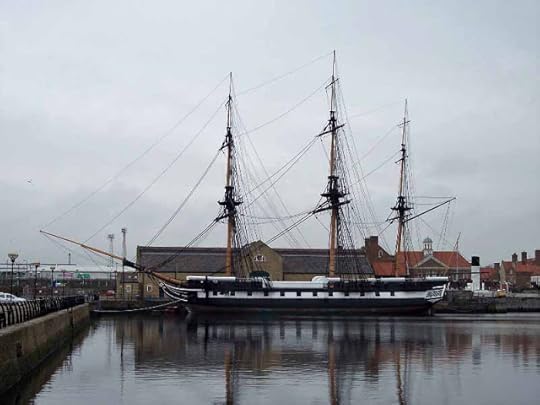 HMS Trincomalee is a frigate built right at the end of the Napoleonic Wars, and can be visited in Hartlepool, UK.
HMS Trincomalee is a frigate built right at the end of the Napoleonic Wars, and can be visited in Hartlepool, UK.Loose cannonToday, a loose cannon is a dangerously uncontrollable person, and the origin of the phrase is from a cannon that has come loose. Loose from what, you may ask.The photo below shows the cannon on one of HMS Victory’s gun decks.
 One of HMS Victory’s gun decks. Sadly almost all of the guns on display on the ship today are made of fibreglass, as the old structure is not strong enough to take the weight of real ones.
One of HMS Victory’s gun decks. Sadly almost all of the guns on display on the ship today are made of fibreglass, as the old structure is not strong enough to take the weight of real ones.The largest guns on Victory were 32 pounders—this meant the weight of each cannonball was 32 lbs (15 kg). The cannon itself weighed about 56 hundredweight, or nearly 3 tonnes. The thick ropes in the photo are to absorb the force of the recoil when the gun fires, and limit the movement to a few feet. This is enough to allow men to reload it, before the thinner ropes are used to pull it closer to the bulkhead again for the next shot.A ship at sea is rarely still, and often pitching and rolling violently. I leave you to imagine the damage that could be if the restraining ropes break. With 3 tonnes of metal loose on a rolling deck, a ‘loose cannon’ could be very dangerous indeed.Nipper‘Nipper’ is UK slang for a child, and comes from the boys used to ‘nip’ anchor cables.
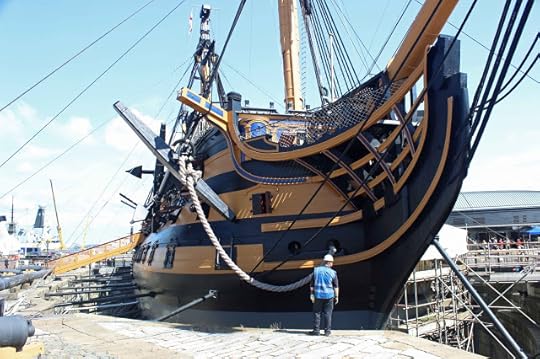 HMS Victory, showing one of her anchors and its cable, with a handy dockyard worker for scale.
HMS Victory, showing one of her anchors and its cable, with a handy dockyard worker for scale.As you can see in the photo, the anchor cable is at least as thick as the man’s arm. Each anchor weighed a couple of tonnes, and the length of cable itself weighed over 4 tonnes. On Victory, the anchor was ‘weighed’ by over 100 men turning two capstans (one mounted above the other on two decks). This cable is far too thick and stiff to be wound around the capstan, so the anchor cable was ‘nipped’ (i.e. fastened) to a thinner, more flexible rope called the messenger cable.

Young boys were responsible for fastening the anchor cable to the messenger cable, then unfastening it again before the anchor cable was fed down to its storage on the orlop deck, and were called nippers.There’s a video here that explains in more detail, if you’re interested (not my video!):
That’s it for now, there are lots more!
The Mrs MacKinnons
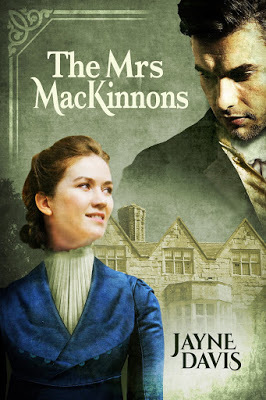 England, 1799Major Matthew Southam returns from India, hoping to put the trauma of war behind him and forget his past. Instead, he finds a derelict estate and a family who wish he'd died abroad.Charlotte MacKinnon married without love to avoid her father’s unpleasant choice of husband. Now a widow with a young son, she lives in a small Cotswold village with only the money she earns by her writing.Matthew is haunted by his past, and Charlotte is fearful of her father’s renewed meddling in her future. After a disastrous first meeting, can they help each other find happiness?
England, 1799Major Matthew Southam returns from India, hoping to put the trauma of war behind him and forget his past. Instead, he finds a derelict estate and a family who wish he'd died abroad.Charlotte MacKinnon married without love to avoid her father’s unpleasant choice of husband. Now a widow with a young son, she lives in a small Cotswold village with only the money she earns by her writing.Matthew is haunted by his past, and Charlotte is fearful of her father’s renewed meddling in her future. After a disastrous first meeting, can they help each other find happiness?4.7* average on Amazon, available on Kindle Unlimited.Amazon
Jayne Davis
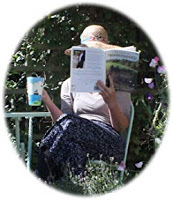 Jayne Davis writes historical romances set in the late Georgian/Regency era, published as both ebooks and paperbacks.She was hooked on Jane Austen and Georgette Heyer as a teenager, and longed to write similar novels herself. Real life intervened, and she had several careers, including as a non-fiction author under another name. That wasn't quitethe writing career she had in mind...Finally, she got around to polishing up stories written for her own amusement in long winter evenings, and became the kind of author she’d dreamed of in her teens. She is now working on the first few books in the Marstone Series, set in the late Georgian/early Regency period.
Jayne Davis writes historical romances set in the late Georgian/Regency era, published as both ebooks and paperbacks.She was hooked on Jane Austen and Georgette Heyer as a teenager, and longed to write similar novels herself. Real life intervened, and she had several careers, including as a non-fiction author under another name. That wasn't quitethe writing career she had in mind...Finally, she got around to polishing up stories written for her own amusement in long winter evenings, and became the kind of author she’d dreamed of in her teens. She is now working on the first few books in the Marstone Series, set in the late Georgian/early Regency period.You can find Jayne: Website • Pinterest.
Published on October 01, 2018 23:00
No comments have been added yet.
The Coffee Pot Book Club
The Coffee Pot Book Club (formally Myths, Legends, Books, and Coffee Pots) was founded in 2015. Our goal was to create a platform that would help Historical Fiction, Historical Romance and Historical
The Coffee Pot Book Club (formally Myths, Legends, Books, and Coffee Pots) was founded in 2015. Our goal was to create a platform that would help Historical Fiction, Historical Romance and Historical Fantasy authors promote their books and find that sometimes elusive audience. The Coffee Pot Book Club soon became the place for readers to meet new authors (both traditionally published and independently) and discover their fabulous books.
...more
...more
- Mary Anne Yarde's profile
- 159 followers



